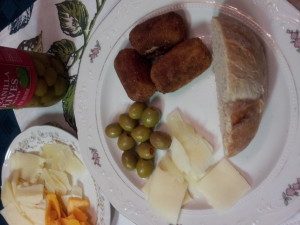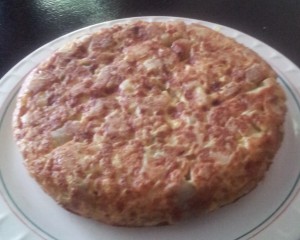When I first went to Spain, I wasn’t a very good cook. Well, I wasn’t really a cook at all, I guess. I was pretty good at desserts, if they came out of boxes, that is, and I could make baked potatoes and egg sandwiches, and spaghetti. That’s about it. But in Spain I married a man whose parents were professional chefs–and though he himself was also not a cook, he was used to eating well. Fortunately, his parents took pity on my inexperience and taught me. For a good three years, I was their unofficial apprentice.
“Here, put on this apron and start slicing those potatoes,” they would say as I entered the kitchen.
Having trained as a scientist, and wholly unschooled in the art of cooking, I wanted to take notes. “How much onion do you need to add to that tortilla?” I’d ask.
“Lo que te pide. As much as it asks for.” Well, that wasn’t much help.
“How much salt?” I would persist.
“Al ojo. Just watch and see what it needs.” Ditto the above sentiment.
But slowly, I did catch on. Food does talk to you, if you know what to listen for, and you really can figure out what’s needed just by paying attention. Most importantly, I learned not to be afraid to try new combinations and vary the amounts of ingredients. Oh, I’ve burned things, added way too much salt or too little butter–my kids can tell you plenty of stories about the times my cooking has gone wrong. I’ve been fortunate to have such wonderful children, though, who rally around me when culinary disaster strikes, helping to scrape the burned bits off of the stew pieces to rescue as much of it as possible, swearing that they actually do like the food that way, with the little black flecks of charcoal in it and a smoky taste. But those disasters rarely happen anymore. And when my children have come back from college, “your cooking” is what they each named as the thing they missed the most.
I mostly cook Spanish style, and when people ask me how much onions or salt I put in the lentils, I find myself leaning toward answering the same as my in-laws did, lo que te pide, or al ojo. I now see the wisdom of not following recipes and tight prescriptions, but rather “cooking by feel,” so to speak. So, the recipes you’ll find on this page may have their vague parts, and they may turn out differently in your home. That’s all good. Be creative. Have fun. Let me know if you have any questions or comments, feel free to post pictures of my recipes that you try at home, and do ask if there’s something in particular you’d like to learn how to make. If I know how, I’ll write a post on it. Oh, and one more thing: make sure you always add plenty of love to whatever you’re cooking and you’ll become an artist in your own kitchen!







2 comments
I am excited to try your recipes!
Author
You’ll have to let me know how they turn out! Feel free to post a picture! 🙂